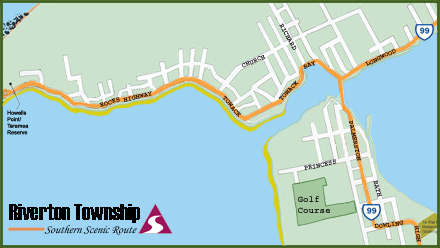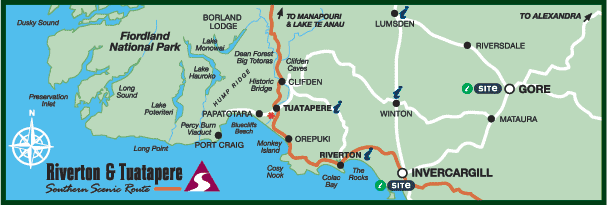
2025 edition
 Riverton was the first recorded settlement in New Zealand. For centuries people have come here. And now it''s your turn. Riverton is the private face of a small island nation at the bottom of the world. It is the real New Zealand. Welcome.
Riverton was the first recorded settlement in New Zealand. For centuries people have come here. And now it''s your turn. Riverton is the private face of a small island nation at the bottom of the world. It is the real New Zealand. Welcome.
Today Riverton has many faces. It is a place of young geography and raw natural beauty. A fishing port. A seaside holiday resort. An artists'' colony. The fishermen and hunters'' last frontier. A farming centre. Small town New Zealand just getting on with it.
And the locals? Like those who came before us, we believe we can make something of ourselves here. So we stay. And fish and farm and mill and mine and work in hotels, shops, sheds and studios. Riverton is our community so we sit on committees for schools, local government, clubs and essential services.
In our spare time we hunt, fish, garden, do craft work and play sport. And visitors punctuate our lives and some find what they have been looking for here. So they stay and become our newest settlers. Perhaps you may be one of them.
Voices From Our Past
The Riverton story begins with our Polynesian ancestors. Through necessity or the simple desire to find out what was on the next island, our ancestral canoes left the higher South Pacific for southern shores.
"How many times have I told you, hang on to the kumara. Who knows if there is anything to eat where we are going."
And four or five centuries later came the European explorers, Dutchman Abel Tasman and Englishman Captain James Cook.
"Be a good fellow Jim and see if you can get to the bottom of this Terra australis incognita thing. See you in a few years old boy and don''t forget the flag. God Speed."
Two decades later Riverton had established commerce and commerce had established Riverton. Sealers and Whalers from many nations had arrived. The generous estuary formed by the confluence of the Aparima and Pourakino Rivers provided a safe haven from their perilous maritime endeavours. They liked what they saw. A temperate climate, plentiful fish and timber reserves and arable land as far as the telescope could see.
"A man could make something of hissel'' here George. Be more than a Lord''s lackey. Get some land, have a family. I''m for staying."
And stay they did. And mixed and mingled with the local Maori and broke in land and built houses and had families and went about the difficult business of living in early Riverton.
Perhaps the whaler who left the most enduring legacy was Captain John Howell (1809-74) who established a whaling station in Riverton in 1835. He took as his wife a high ranking Maori woman and accumulated vast local landholdings through this alliance. He also persuaded many former whalers to join him in a life ashore. He is buried in the Riverton cemetery.
Enter the missionary, for wherever people congregate in remote locations theirs is the duty to bring order to the untidy affairs of men. The missionaries married, baptised, educated, medicated, ministered and brought His Word to the hard living men of the southern coast.
"Baptism in the Aparima River, 10 o''clock Sunday. Round up the kids."
By the 1850''s the trickle of European settlers became a wave and the wave an ocean. What dreams were theirs on a hazardous four-month sailing ship voyage to a faraway country they knew little about? Peace? Freedom? Prosperity?
An early settler tells his own story.
"I was born near Glasgow and brought up to a life of farming. I came to New Zealand by the ship Jessie Readman in 1867 with my parents and three brothers. I acquired two hundred acres of land near Riverton which I have brought to a state of cultivation."
But in his perversity the man yearns for the old whilst simultaneously seeking the new. So he brings the rabbit, the sparrow, pheasant, trout and deer to his new home. For aren''t these too the possessions of a landowner, and in this new country doesn''t he own land? So for better or for worse new species of the feathered, furred and finned settled alongside him.
And the people investigated a multitude of ways to win their daily bread from the new land. They farmed and fished and milled and mined and set about establishing the essentials of civilised society; schools, hospitals, banks and shops. And so it is.
But when you are here ponder this. The lady who serves your drink may be a descendant of the sealer who thought he could make something of himself here. The man who waves to you from his tractor could be the great great grandson of a missionary. And that boy on his skateboard outside the supermarket could well be distantly related to the fellow who protected the food on the great canoe voyage from Polynesia.
Places To Visit ... Things To Do

Nearby
Environmental
Aparima Pest Busters
Retirement means different things to different people but for a group of retired men in Riverton it means dong their bit to protect and even hopefully increase native bird numbers.
The initial group of Warrick McCallum, Jim Dixon and Allan Broomfield are still enthusiastic about the work they are doing together as the Aparima Pest Busters.
Their awareness and activity was activated by the experiences of Mr McCallum and Mr Dixon throughout many years at the Riverton Golf Course where they noticed that it was a feeding ground for a large number of small native and introduced birds.
This remained the case until magpies made inroads to Southland.
These birds'' territorial habits and dominant attitude forced the small birds back to the safety of the bush.
Golfers had to put up with the unpredictable nature of the magpies which swooped down and dive-bombed the players during their games.
This initiated the actions of the two men, along with friend Mr Broomfield, to carry out a programme to get rid of the magpie problem and ensure the survival of the native birds and also the safety of the golfers.
The action group was formed and called the Aparima Pest Busters.
The magpie traps and stoat cages were constructed by Mr Dixon whose carpentry skills proved invaluable, producing immediate successes with many magpies being caught.
However, Environment Southland bio-security officer Nick Rosewarne suggested that for the operation to be more effective there was a need to eliminate the rat population in the bush to ensure the survival of the native birds.
The pest busters decided to take up the challenge and targeted the forest area of Howell Hills above Riverton.
One hundred and fifty possum and rat bait stations, as well as a small number of stoat traps, were placed throughout the More''s Reserve area in an attempt to get rid of the predators.
To assist with the maintenance and re-baiting of the traps, John Bailey and Ken Tefler joined the group.
A loan service for magpie traps, which are available to landowners who wish to eliminate magpies from their properties, is run via the group.
Gummies Bush farmer Mervyn de Clifford has trapped more than 500 birds in and around his district.
Since the pest busters'' trapping programme began 14 months ago, more than 2500 magpies have been caught.
With the large amount of poison taken, the rat and possum populations have been reduced considerably.
Another positive side of the pest busters'' operations has been the removal of noxious plants in More''s Reserve.
Chilean flame creeper, blackberry and holly trees are the main species targeted for eradication.
Support received from Environment Southland''s Randall Milne and Southland District Council reserve officer Sandra Clearwater has been helpful and appreciated, Mr McCallum said.
Their contribution has played a significant part in the success of the Return of the Birds project.
"We are often asked, ''Why do you guys do it?''?," Mr McCallum said.
"Our reply is that our main aim is to actively make sure the environment is protected. This means the species can breed in safety with the populations hopefully being returned to their former numbers."
The group have noticed how the presence of bird life had declined dramatically over the years.
"It was not too long ago that when you were in the bush the fantails and bush robins would follow you", Mr McCallum said.
"They would continually flutter around you, proudly displaying their presence. If our efforts to get rid of the predators are successful, that will be reward enough, just to see those birds there in large numbers again."
They agree that being in the bush was special.
2004 Environment Awards ~ Environmental Innovators and winner of the 2004 Community Group section ~ Aparima Pest Busters
Who would have thought chivalry would be motivation to get involved in caring for the environment...but a group of gentlemen from Riverton, upset at their lady golfers being dive-bombed by magpies, began a rampage against pests. The Aparima Pest Busters are Southland''s answer to Robin Hood and his merry men - they don''t steal form the rich, but they certainly do give to the poor old forest. They''ve whacked pest plants and animals, installed traps, replanted native vegetation and they''ve encouraged locals to join their ''Return of the Birds'' programme - with over 35-bird-friendly back yards established in Riverton.
The success of the Pest Busters work has been recognized nationwide. Innovation, leadership and sheer determination have shaped their efforts and the results are obvious - an area once environmentally-depleted now brimming with life.
| This Site © A To Z Publications Ltd, New Zealand, 1997 - 2025. Enquiries to info@atoz-nz.com |